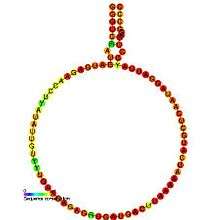Small nucleolar RNA SNORD115
| Small nucleolar RNA SNORD115 | |
|---|---|
 Predicted secondary structure and sequence conservation of SNORD115 | |
| Identifiers | |
| Symbol | SNORD115 |
| Alt. Symbols | snoHBII-52; HBII-52 |
| Rfam | RF00105 |
| Other data | |
| RNA type | Gene; snRNA; snoRNA; CD-box |
| Domain(s) | Eukaryota |
| GO | 0006396 0005730 |
| SO | 0000593 |
SNORD115 (also known as HBII-52) is a non-coding RNA (ncRNA) molecule known as a small nucleolar RNA which usually functions in guiding the modification of other non-coding RNAs. This type of modifying RNA is usually located in the nucleolus of the eukaryotic cell which is a major site of snRNA biogenesis. HBII-52 refers to the human gene, whereas RBII-52 is used for the rat gene and MBII-52 is used for naming the mouse gene.
HBII-52 belongs to the C/D box class of snoRNAs which contain the conserved sequence motifs known as the C box (UGAUGA) and the D box (CUGA). Most of the members of the box C/D family function in directing site-specific 2'-O-methylation of substrate RNAs.[1]
In the human genome, HBII-52 is encoded in a tandemly repeated array with another C/D box snoRNA, HBII-85 (SNORD116), in the Prader-Willi syndrome (PWS) region of chromosome 15.[2] However, a microdeletion in one family of the snoRNA HBII-52 cluster has excluded it from playing a major role in the disease.[3] HBII-52 is found in 47 tandem near identical copies on human chromosome 15q11-13. This locus is maternally imprinted, meaning that only the paternal copy of the locus is transcribed. HBII-52 is exclusively expressed in the brain but is absent in PWS patients. HBII-52 lacks any significant complementarity with ribosomal RNAs, but does have an 18 nucleotide region of conserved complementarity to serotonin 2C receptor mRNA.[4] The serotonin 2C receptor is also expressed in the brain. It has been shown that this snoRNA is likely to bind to a silencing element of exon Vb increasing its inclusion and production of a functional spliceform of the serotonin 2C receptor.
The chromosomal locus containing the SNORD115 gene cluster has been duplicated in many individuals with autistic traits.[5][6] A mouse model engineered to have a duplication of the SNORD115 cluster displays autistic-like behaviour.[7]
There is evidence that a truncated form of MBII-52 (SNORD115 found in mouse) regulates the alternative splicing of the protein coding genes DPM2, TAF1, RALGPS1, PBRM1, and CRHR1.[8]
References
- ↑ Galardi, S.; Fatica, A.; Bachi, A.; Scaloni, A.; Presutti, C.; Bozzoni, I. (October 2002). "Purified Box C/D snoRNPs Are Able to Reproduce Site-Specific 2'-O-Methylation of Target RNA in Vitro". Molecular and Cellular Biology. 22 (19): 6663–6668. doi:10.1128/MCB.22.19.6663-6668.2002. PMC 134041
 . PMID 12215523.
. PMID 12215523. - ↑ Cavaillé J, Buiting K, Kiefmann M, et al. (2000). "Identification of brain-specific and imprinted small nucleolar RNA genes exhibiting an unusual genomic organization". Proc. Natl. Acad. Sci. U.S.A. 97 (26): 14311–6. Bibcode:2000PNAS...9714311C. doi:10.1073/pnas.250426397. PMC 18915
 . PMID 11106375.
. PMID 11106375. - ↑ Runte M, Varon R, Horn D, Horsthemke B, Buiting K (2005). "Exclusion of the C/D box snoRNA gene cluster HBII-52 from a major role in Prader-Willi syndrome". Hum Genet. 116 (3): 228–30. doi:10.1007/s00439-004-1219-2. PMID 15565282.
- ↑ Kishore S, Stamm S (January 2006). "The snoRNA HBII-52 regulates alternative splicing of the serotonin receptor 2C". Science. 311 (5758): 230–2. Bibcode:2006Sci...311..230K. doi:10.1126/science.1118265. PMID 16357227.
- ↑ Bolton PF, Veltman MW, Weisblatt E, et al. (September 2004). "Chromosome 15q11-13 abnormalities and other medical conditions in individuals with autism spectrum disorders". Psychiatr. Genet. 14 (3): 131–7. doi:10.1097/00041444-200409000-00002. PMID 15318025.
- ↑ Cook EH, Scherer SW (October 2008). "Copy-number variations associated with neuropsychiatric conditions". Nature. 455 (7215): 919–23. Bibcode:2008Natur.455..919C. doi:10.1038/nature07458. PMID 18923514.
- ↑ Nakatani J, Tamada K, Hatanaka F, et al. (June 2009). "Abnormal behavior in a chromosome-engineered mouse model for human 15q11-13 duplication seen in autism". Cell. 137 (7): 1235–46. doi:10.1016/j.cell.2009.04.024. PMC 3710970
 . PMID 19563756.
. PMID 19563756. - ↑ Kishore S, Khanna A, Zhang Z, Hui J, Balwierz PJ, Stefan M, Beach C, Nicholls RD, Zavolan M, Stamm S (2010). "The snoRNA MBII-52 (SNORD 115) is processed into smaller RNAs and regulates alternative splicing". Hum Mol Genet. 19 (7): 1153–64. doi:10.1093/hmg/ddp585. PMC 2838533
 . PMID 20053671.
. PMID 20053671.